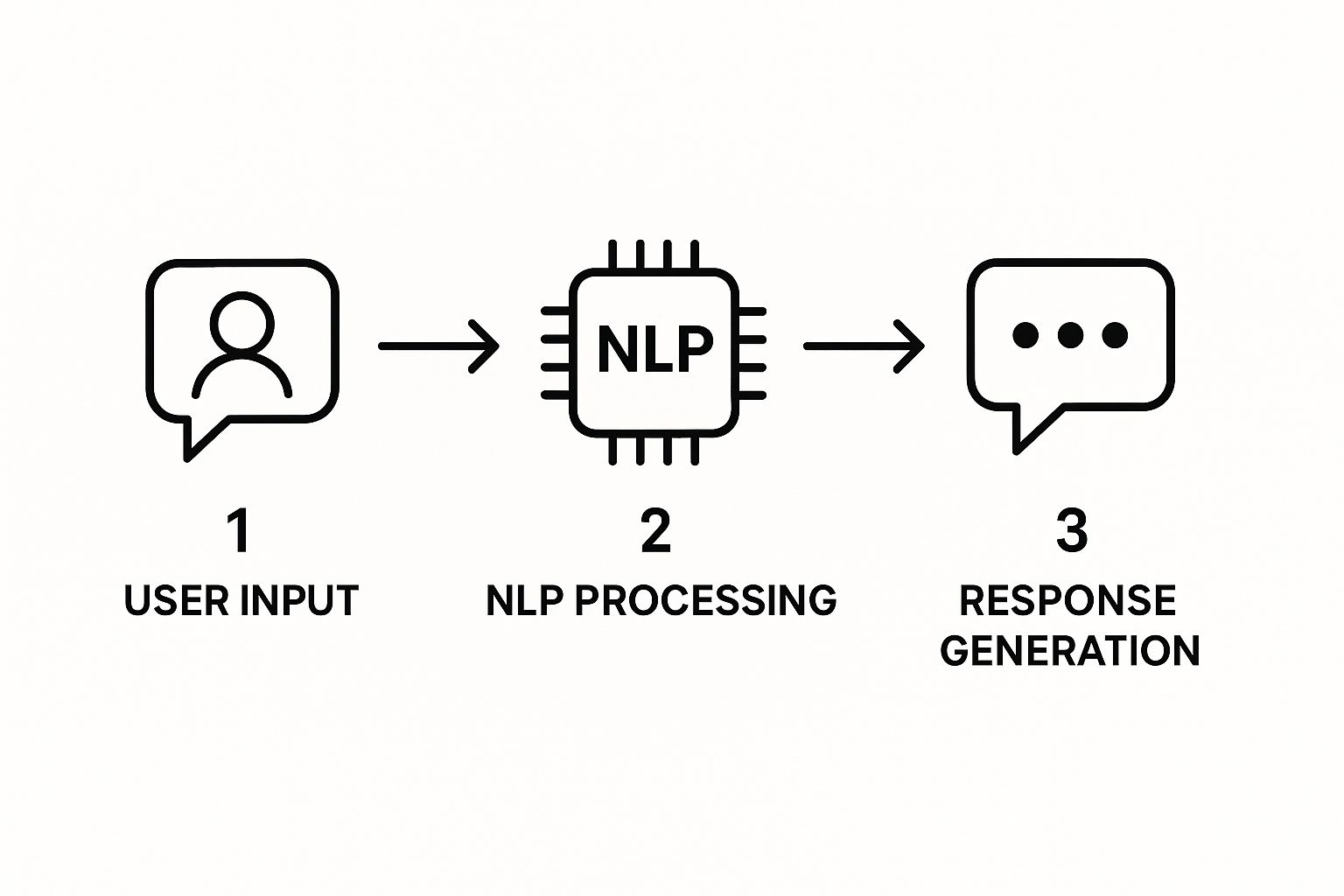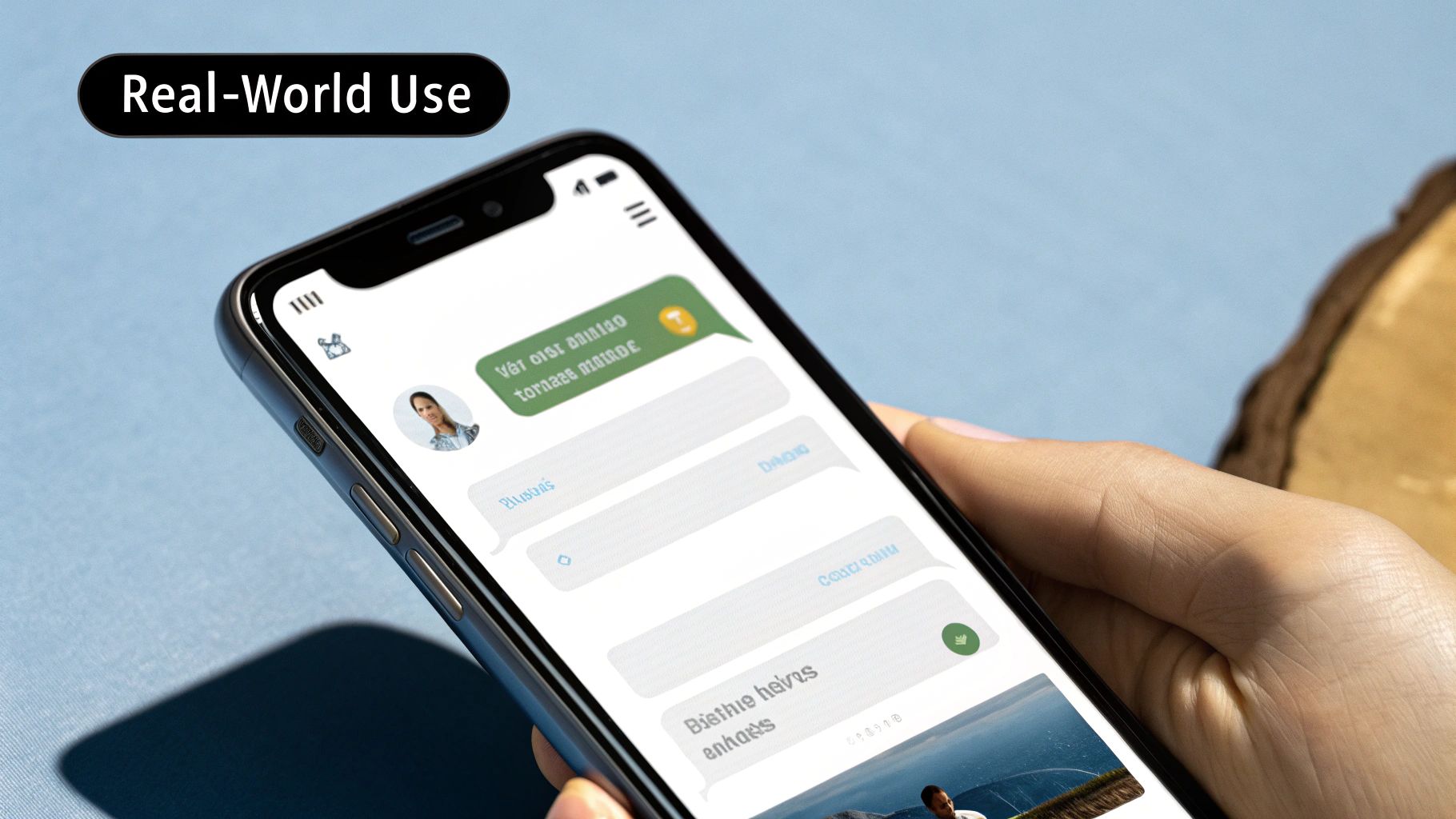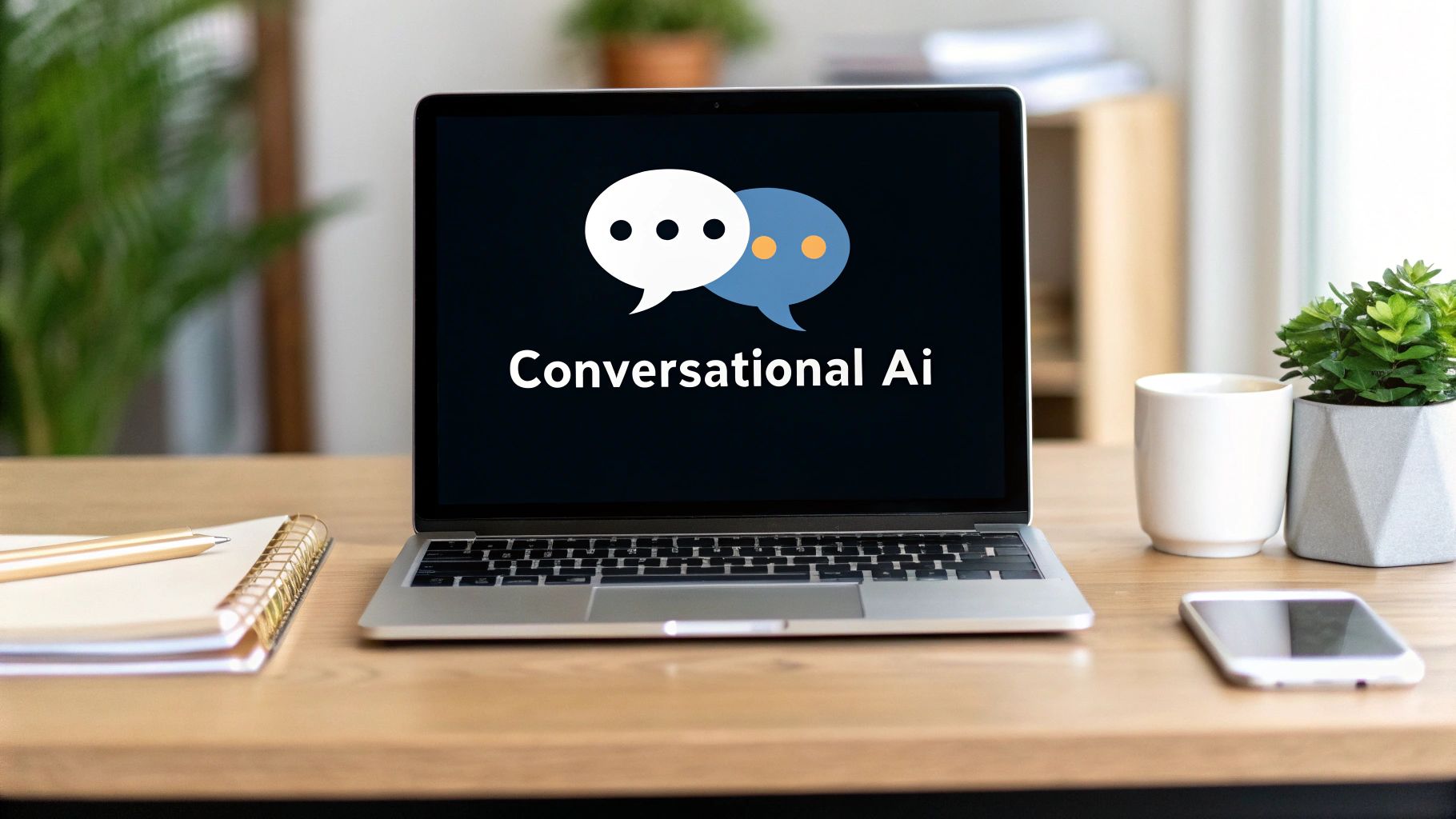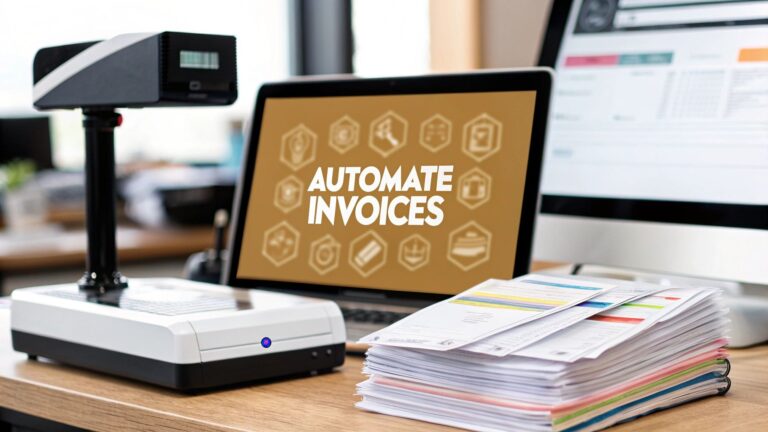What Is Conversational AI? Discover How It Transforms Customer Experiences
At its core, conversational AI is all about making computers understand and speak our language—not the other way around. It’s the technology that lets us talk to devices like Siri or Alexa just like we would talk to another person.
The goal is to simulate a real, human-like conversation, getting to the heart of what you actually mean, not just the specific words you type or say.
So, What Is Conversational AI Really?
Picture yourself ordering coffee. You could ask for a "large black coffee," a "venti Americano," or even just say, "Give me the biggest, darkest coffee you've got." A good barista gets it. They understand all three requests are for the exact same thing.
That’s conversational AI in a nutshell. It’s built to grasp the context, intent, and subtle nuances of human language. This is a huge leap from older systems that relied on rigid, keyword-based commands.
Unlike a simple chatbot that follows a strict script, conversational AI learns and adapts from every single interaction. This lets it tackle complex, multi-part questions and deliver more accurate, personalized answers over time. It's the difference between a bot that just points you to an FAQ page and a digital assistant that actually helps solve your problem.
More Than Just a Chatbot
People often throw the terms "chatbot" and "conversational AI" around as if they're the same, but they're worlds apart in terms of what they can do. Think of it this way: while you can build a chatbot using conversational AI, most basic chatbots don't have that sophisticated engine running under the hood. For a business, understanding this difference is key.
A traditional chatbot is like a flowchart. It follows a pre-written script and gets stuck if you deviate. Conversational AI, on the other hand, uses machine learning to understand context and create responses on the fly. It’s the difference between reading from a script and having a genuine conversation.
So, what really sets true conversational AI apart?
- Understanding Intent: It figures out what a user is trying to accomplish, even if they use slang, typos, or phrase their question in a weird way. A basic bot just looks for specific keywords and often gets stuck.
- Contextual Memory: It remembers what you talked about earlier in the conversation, leading to a much smoother, more natural flow. You don't have to repeat yourself.
- Continuous Learning: Every conversation is a lesson. The AI gets smarter and more effective with each interaction, all without someone needing to manually reprogram it.
Let's break down the key differences more clearly.
Conversational AI vs Traditional Chatbots
This table highlights the fundamental differences between dynamic conversational AI and older, rule-based chatbot technology.
| Capability | Traditional Chatbot | Conversational AI |
|---|---|---|
| Understanding | Relies on specific keywords and pre-programmed rules. | Understands intent, context, and sentiment. |
| Conversation Flow | Follows a rigid, decision-tree script. Easily broken. | Can handle non-linear, multi-turn conversations. |
| Learning | Static. Requires manual updates to improve. | Learns and improves from every interaction. |
| Language Use | Limited vocabulary; struggles with slang or typos. | Manages complex grammar, slang, and user errors. |
| Personalization | Offers generic, one-size-fits-all responses. | Provides personalized, context-aware answers. |
Ultimately, choosing between a traditional chatbot and a conversational AI platform comes down to the experience you want to create. One is built for simple, repetitive tasks, while the other is designed for dynamic, helpful, and truly human-like interactions.
How Conversational AI Actually Thinks
Ever wonder what’s happening under the hood when you chat with an AI? It feels like magic, but it's really a clever, multi-step process designed to break down human language, figure out what you mean, and then craft a useful reply.
The engine driving this entire operation is Natural Language Processing (NLP). You can think of NLP as the AI's brain. It has two primary jobs that work in tandem: first, understand what the person is asking, and second, generate a response that makes sense. Let's break down how it handles each of those tasks.
First, It Understands Your Intent (NLU)
The first piece of the puzzle is Natural Language Understanding (NLU). Its whole purpose is to figure out the intent behind your words. When a customer types, "Where's my latest order?", NLU doesn't just read the words. It pinpoints the user's goal—in this case, "track an order"—and pulls out the important details, like "latest order."
This is where a good conversational AI really shines. A customer could ask the same question a dozen different ways ("check my order status," "when will my package get here?"), but a well-trained NLU system knows they're all asking for the same thing. This ability to grasp context is often powered by sophisticated natural language processing and, in many cases, custom in-house LLM development.
This simple three-stage process is what powers every single AI conversation.

From the moment a user types a message to the second the AI responds, this flow shows how human language is translated into something a machine can act on and then back again.
Then, It Crafts a Human-Like Reply (NLG)
Once the AI gets what you're asking for, Natural Language Generation (NLG) steps in. This is the part of the system that actually writes the reply. It takes the structured information and intent identified by the NLU and translates it back into natural, conversational language.
So, for our order tracking example, the NLG component would pull the latest shipping data and then construct a sentence that sounds human, like, "Good news! Your order #55-321 is out for delivery and should arrive later today."
Machine Learning is the secret sauce that makes all of this get smarter over time. Every single interaction—every question, every piece of feedback—is a chance for the AI to learn. It refines its understanding and improves its responses automatically, without a developer needing to step in and code new rules.
This continuous learning loop is what turns a basic chatbot into a genuinely valuable business tool. It’s no wonder the global market is projected to hit an incredible $132.86 billion by 2034. This growth is fueled by massive demand for better AI-powered customer support and its expanding use in critical industries like healthcare. The AI just keeps getting better on its own, becoming a more reliable and effective part of your team.
Real-World Business Benefits You Can Expect

It’s one thing to understand the mechanics of conversational AI, but what really matters is how it impacts your bottom line. This isn't just a fancy tech trend; it's a genuine engine for growth that delivers tangible returns in customer experience, operational efficiency, and even sales. At its core, it creates value by solving fundamental business problems in a smarter, more scalable way.
Instead of making customers wait in a queue for the next available agent, conversational AI provides instant, 24/7 support. That constant availability means you never miss a chance to help someone, whether it's 3 PM on a Tuesday or 3 AM on a Sunday. This kind of immediate access to help and information cuts down on customer frustration and builds a much stronger, more reliable brand image.
Elevate Your Customer Experience
In today's market, a great customer experience is non-negotiable. Conversational AI acts like a dedicated assistant for every single user, offering a level of personalized help that traditional support channels just can't scale to match. It can remember a customer's past interactions, anticipate what they might need next, and give them tailored recommendations or solutions on the spot.
Think about an e-commerce site. An AI assistant can guide a shopper through finding the right product, answer questions about sizing, and even process a return without needing a human to step in. This turns what could be a frustrating process into a smooth, positive interaction. Our guide offers more strategies on how to improve customer experience with modern tools.
By automating the routine, day-to-day interactions, businesses can handle a much higher volume of inquiries without letting quality slip. In fact, research shows that bringing AI into contact centers can slash operational costs by up to 30% while simultaneously boosting customer satisfaction scores.
Drive Major Operational Efficiency
Beyond just helping customers, this technology is a game-changer for internal workflows and productivity. Consider all the repetitive, time-consuming tasks that slow your team down—things like answering the same IT helpdesk questions over and over, routing lead information, or scheduling meetings. Conversational AI can take all of that off their plate.
This frees up your people to focus on the high-value, complex problems that actually require human creativity and emotional intelligence. The end result? A more efficient, motivated, and productive workforce.
- Task Automation: Instantly handles routine queries and tedious data entry.
- Resource Allocation: Lets your team concentrate on strategic goals instead of busywork.
- Reduced Training Time: Automates parts of employee onboarding and internal support.
Boost Revenue and Guide Sales
Finally, conversational AI is a powerful, proactive sales tool. It can engage with website visitors the moment they arrive, qualify leads around the clock, and gently guide potential customers through your sales funnel. By answering questions and handling objections in real-time, it helps turn casual interest into genuine action.
A SaaS company, for example, could use an AI assistant to book demos with qualified leads directly on its website. This immediately shortens the sales cycle and boosts conversion rates. Your website transforms from a static brochure into a dynamic, revenue-generating machine that’s actively working to grow your business.
Where Conversational AI Shines in Business

The theory behind conversational AI is interesting, but its real power is in solving tangible, everyday business problems. This isn't just a niche tool; it’s incredibly adaptable, showing up everywhere from customer service departments to internal HR teams.
The most familiar example for most of us is customer support automation. Think about a retail website during a massive Black Friday sale. Instead of leaving customers on hold for an hour, an AI assistant can instantly field thousands of questions about order tracking, return policies, and stock levels. This leaves your human agents free to handle the truly tricky situations that require a personal touch.
A New Engine for Sales and Lead Generation
Sales teams are also finding a powerful ally in conversational AI. It acts as a tireless front-line qualifier, working 24/7 to engage potential customers the second they land on your site. The AI can ask smart, qualifying questions to gauge interest and figure out if a visitor is a solid lead.
For a SaaS company, this is a game-changer. Imagine a chatbot on your pricing page that can:
- Explain the differences between subscription tiers.
- Suggest the best plan based on a visitor's described needs.
- Book a demo directly on a sales rep's calendar if the lead is hot.
Suddenly, your website isn't just a brochure—it's an interactive machine for generating qualified leads. For companies ready to take this step, exploring personalized chatbot solutions is a great way to start driving that growth.
Making Internal Operations Run Smoother
Conversational AI isn’t just for talking to customers. Businesses are increasingly turning it inward to boost efficiency and make life easier for their own teams. An internal AI helpdesk, for instance, can walk an employee through a password reset or answer common questions about HR benefits, slashing the number of support tickets.
It’s also a huge help in HR, where it can guide new hires through the onboarding maze of paperwork and initial questions. This creates a much smoother welcome and gets people up to speed faster. We dive deeper into these kinds of internal applications in our guide to https://makeautomation.co/ai-automation-for-business/.
This widespread adoption is why the market is exploding. By 2030, the conversational AI market is expected to surge past $41 billion. It’s no surprise when you see that over 50% of companies are already using it in their contact centers, with another 40% planning to roll it out soon.
Whether it’s scheduling patient appointments in a clinic or processing insurance claims, conversational AI is quickly becoming essential. It takes the repetitive work off our plates, delivers instant answers, and frees up people to focus on the strategic thinking that really moves the needle.
How to Choose the Right Conversational AI Solution
Picking the right conversational AI platform is a huge decision. It's not just about adding a cool new tool; it's a choice that will directly affect your customer satisfaction scores and how efficiently your teams operate. With a sea of options out there, it's easy to get distracted by fancy bells and whistles.
The key is to cut through the noise. You need to focus on what your business actually needs to achieve its goals. A platform that's a home run for a massive e-commerce company could easily strike out for a growing SaaS business.
The absolute first place to start is with your existing technology. A powerful AI solution that can't talk to your CRM, helpdesk, or other core software is a non-starter. It’ll just create data silos and headaches. Seamless integration isn’t a "nice-to-have"—it's the foundation of a unified customer experience.
Define Your Core Requirements
Before you even start looking at demos, you need a crystal-clear picture of what you want this AI to do. What's the job you're hiring it for?
Are you trying to deflect a flood of common support tickets? Or maybe you need it to qualify inbound leads so your sales team can focus on hot prospects? Perhaps you need it to offer basic technical help around the clock. Your main goal will determine everything else.
Start by making a simple checklist of your non-negotiables:
- Integration Capabilities: Does it play nice with the tools you already rely on, like Salesforce, Zendesk, or HubSpot?
- Scalability: Can this thing grow with you? You need a platform that can handle a jump from 100 conversations a day to 10,000 without breaking a sweat.
- Customization: Can you tweak the AI's personality? The ability to match its voice and tone to your brand is critical for a consistent feel.
- Analytical Dashboards: Does it give you data you can actually use? You need clear insights into conversation quality, user satisfaction, and what people are asking about most often.
A successful conversational AI implementation isn’t just about technology; it’s about choosing a solution that becomes a natural extension of your team. The right tool should empower your staff, not create extra work for them.
Build vs. Buy: The Right Approach
Another big fork in the road is deciding whether to build your own custom solution or buy an established platform. It’s a classic dilemma.
Building it yourself gives you total control, but don't underestimate the resources required. It demands deep technical expertise, a long timeline, and a dedicated team for ongoing maintenance and updates. For most B2B and SaaS companies, buying a ready-made solution is simply more practical and gets you a return on your investment much faster.
As you explore your options, it can also be incredibly helpful to get an outside perspective. Consulting with top chatbot interface design agencies can offer valuable insights into crafting an experience that users will actually enjoy interacting with.
Ultimately, understanding what AI is in business is about seeing it as a problem-solving tool. Choosing the right one is the first, and most important, step.
The Future of Human and AI Collaboration

When we look at what’s next for conversational AI, the conversation is shifting. It’s no longer about replacing people; it's about amplifying what they do best. The real goal is to forge a smart partnership where AI takes on the tedious, data-heavy work. This frees up your team to focus on the human stuff—strategy, creativity, and building real customer relationships.
This isn't some far-off concept; it’s already happening. Think about an AI that doesn’t just wait for a customer to ask a question but spots a potential issue and offers a solution before the customer even realizes there’s a problem. That’s the leap from reactive to proactive support, and it’s how businesses will build rock-solid loyalty in the years ahead.
Emerging Trends in AI Interaction
We're quickly moving beyond basic Q&A bots. With generative AI now in the mix, we're seeing tools capable of interactions that are more empathetic, creative, and emotionally aware.
This is where things get really interesting. We're heading toward a future where AI assistants can:
- Deliver Hyper-Personalization: Imagine crafting a completely unique journey for every single user, tailored to their past actions, preferences, and even their current mood.
- Manage Complex Scenarios: The AI won't get stuck on intricate, multi-step problems that used to require escalating to a senior support agent. It will just handle them.
- Generate Creative Content: Your marketing team could have an AI partner that helps draft email campaigns or social media updates, all perfectly aligned with your brand's voice.
The big idea here is to create a seamless blend of human ingenuity and machine efficiency. AI is becoming a true partner, one that enhances your team’s skills and sets a new bar for how a business runs.
You can see this momentum in the market’s massive growth. The global conversational AI market is on track to hit around $18 billion by 2025. That’s a powerful signal. Businesses aren't just investing in automation anymore; they're investing in a new way of working and a deeper form of collaboration. If you want to dive deeper, you can explore more about these market projections and see just how fast the industry is growing.
Still Have Questions About Conversational AI? Let's Clear Things Up
Even after getting the basics down, a few practical questions almost always pop up when businesses start thinking seriously about this technology. Here are the straight answers to the questions we hear most often.
Are Chatbots and Conversational AI the Same Thing?
Not quite, although the terms are often used interchangeably. The simplest way to think about it is that conversational AI is the powerful engine that can make a chatbot incredibly smart.
Many basic chatbots you run into are just following a script. They're rule-based, meaning they can only respond to specific keywords or phrases they've been programmed to recognize. True conversational AI, on the other hand, uses machine learning and Natural Language Processing (NLP) to actually understand what you're asking, figure out the context, and get smarter over time.
Think of it this way: all conversational AI can power a chatbot, but not all chatbots use conversational AI. The real difference is the level of intelligence under the hood.
How Secure Is Customer Data With This Technology?
This is a big one, and rightly so. Anytime you're handling customer information, security has to be front and center.
Any reputable conversational AI platform is built from the ground up with serious security in mind. This means things like end-to-end data encryption and strict compliance with data privacy regulations like GDPR. When you're vetting a provider, make sure you ask pointed questions about their security protocols and how they store, process, and protect your data.
Is This Going to Replace Our Human Support Team?
The short answer is no. The goal isn't to replace people; it's to make them better at their jobs.
Conversational AI is a master at handling the high-volume, repetitive questions that can bog down a support team. Think "What are your hours?" or "Where's my order?" By automating those, you free up your skilled human agents to focus on the tricky, high-stakes issues—the ones that require a real dose of empathy and creative problem-solving.
This creates a powerful partnership. Your team gets to spend its time on more engaging work, which boosts job satisfaction, and your customers get faster answers for simple things and expert help for complex ones. It’s all about making your team more effective, not smaller.
Ready to see how AI and automation can solve real business problems and drive growth? The experts at MakeAutomation can design and implement a custom strategy for your unique needs. Get started with MakeAutomation today!







